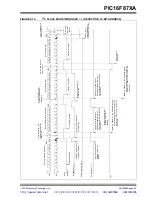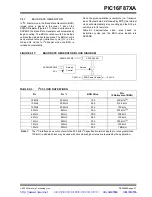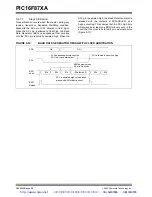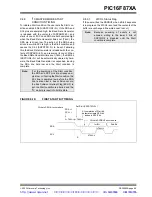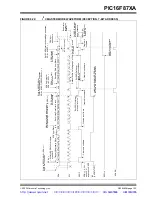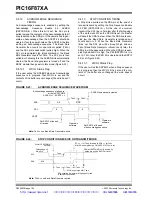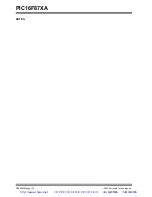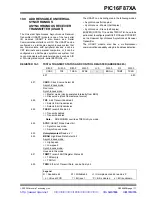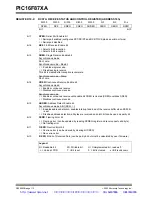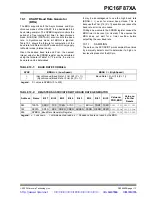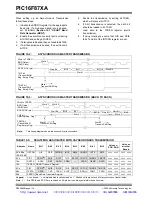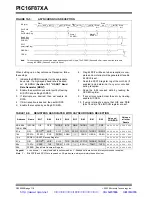
2003 Microchip Technology Inc.
DS39582B-page 105
PIC16F87XA
9.4.14
SLEEP OPERATION
While in Sleep mode, the I
2
C module can receive
addresses or data and when an address match or com-
plete byte transfer occurs, wake the processor from
Sleep (if the MSSP interrupt is enabled).
9.4.15
EFFECT OF A RESET
A Reset disables the MSSP module and terminates the
current transfer.
9.4.16
MULTI-MASTER MODE
In Multi-Master mode, the interrupt generation on the
detection of the Start and Stop conditions allows the
determination of when the bus is free. The Stop (P) and
Start (S) bits are cleared from a Reset or when the
MSSP module is disabled. Control of the I
2
C bus may
be taken when the P bit (SSPSTAT<4>) is set, or the
bus is Idle, with both the S and P bits clear. When the
bus is busy, enabling the SSP interrupt will generate
the interrupt when the Stop condition occurs.
In multi-master operation, the SDA line must be
monitored for arbitration to see if the signal level is at
the expected output level. This check is performed in
hardware with the result placed in the BCLIF bit.
The states where arbitration can be lost are:
• Address Transfer
• Data Transfer
• A Start Condition
• A Repeated Start Condition
• An Acknowledge Condition
9.4.17
MULTI -MASTER COMMUNICATION,
BUS COLLISION AND BUS
ARBITRATION
Multi-Master mode support is achieved by bus arbitra-
tion. When the master outputs address/data bits onto
the SDA pin, arbitration takes place when the master
outputs a ‘
1
’ on SDA by letting SDA float high and
another master asserts a ‘
0
’. When the SCL pin floats
high, data should be stable. If the expected data on
SDA is a ‘
1
’ and the data sampled on the SDA pin =
0
,
then a bus collision has taken place. The master will set
the Bus Collision Interrupt Flag, BCLIF, and reset the
I
2
C port to its Idle state (Figure 9-25).
If a transmit was in progress when the bus collision
occurred, the transmission is halted, the BF flag is
cleared, the SDA and SCL lines are deasserted and the
SSPBUF can be written to. When the user services the
bus collision Interrupt Service Routine and if the I
2
C
bus is free, the user can resume communication by
asserting a Start condition.
If a Start, Repeated Start, Stop or Acknowledge condition
was in progress when the bus collision occurred, the con-
dition is aborted, the SDA and SCL lines are deasserted
and the respective control bits in the SSPCON2 register
are cleared. When the user services the bus collision
Interrupt Service Routine and if the I
2
C bus is free, the
user can resume communication by asserting a Start
condition.
The Master will continue to monitor the SDA and SCL
pins. If a Stop condition occurs, the SSPIF bit will be set.
A write to the SSPBUF will start the transmission of
data at the first data bit regardless of where the
transmitter left off when the bus collision occurred.
In Multi-Master mode, the interrupt generation on the
detection of Start and Stop conditions allows the determi-
nation of when the bus is free. Control of the I
2
C bus can
be taken when the P bit is set in the SSPSTAT register or
the bus is Idle and the S and P bits are cleared.
FIGURE 9-25:
BUS COLLISION TIMING FOR TRANSMIT AND ACKNOWLEDGE
SDA
SCL
BCLIF
SDA released
SDA line pulled low
by another source
Sample SDA. While SCL is high,
data doesn’t match what is driven
Set bus collision
interrupt (BCLIF)
by the master. Bus collision has occurred.
by master
Data changes
while SCL =
0
http://www.xinpian.net
提供单片机解密、IC解密、芯片解密业务
010-62245566 13810019655



